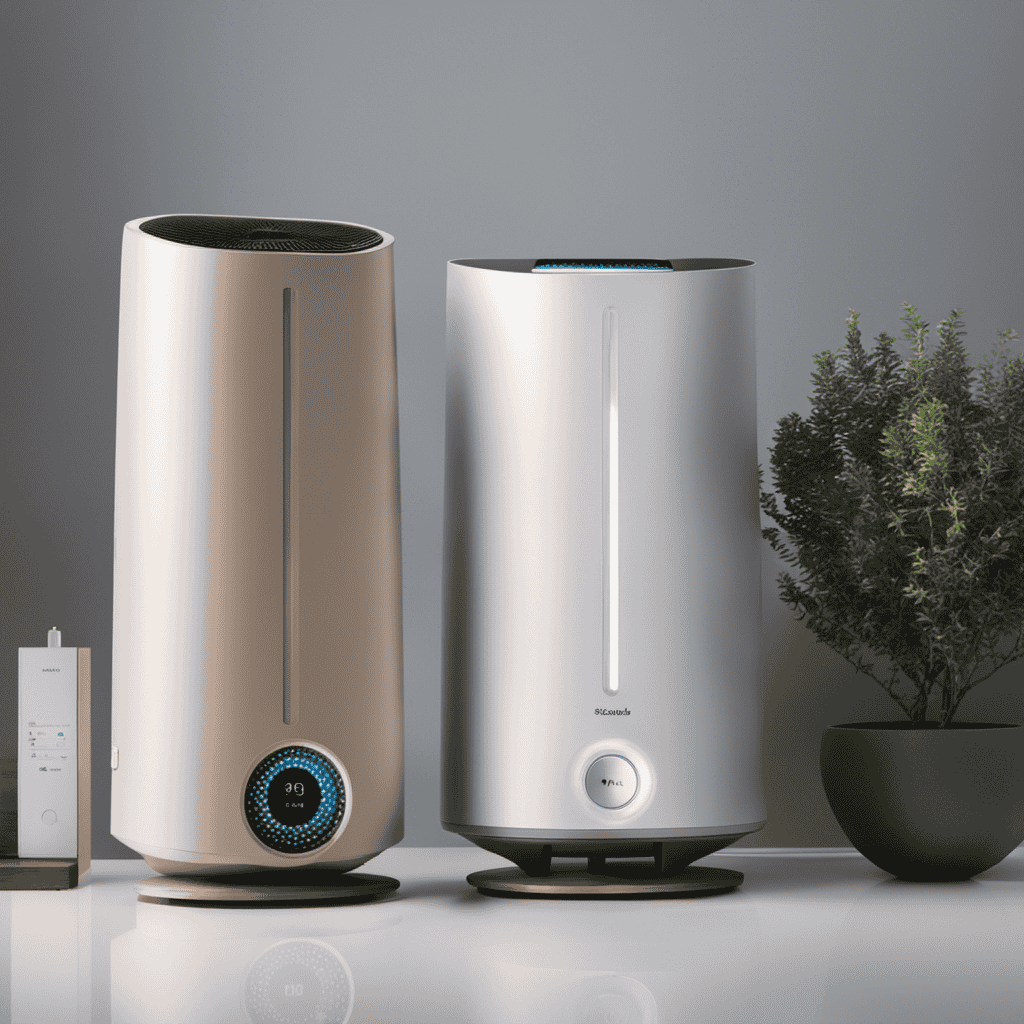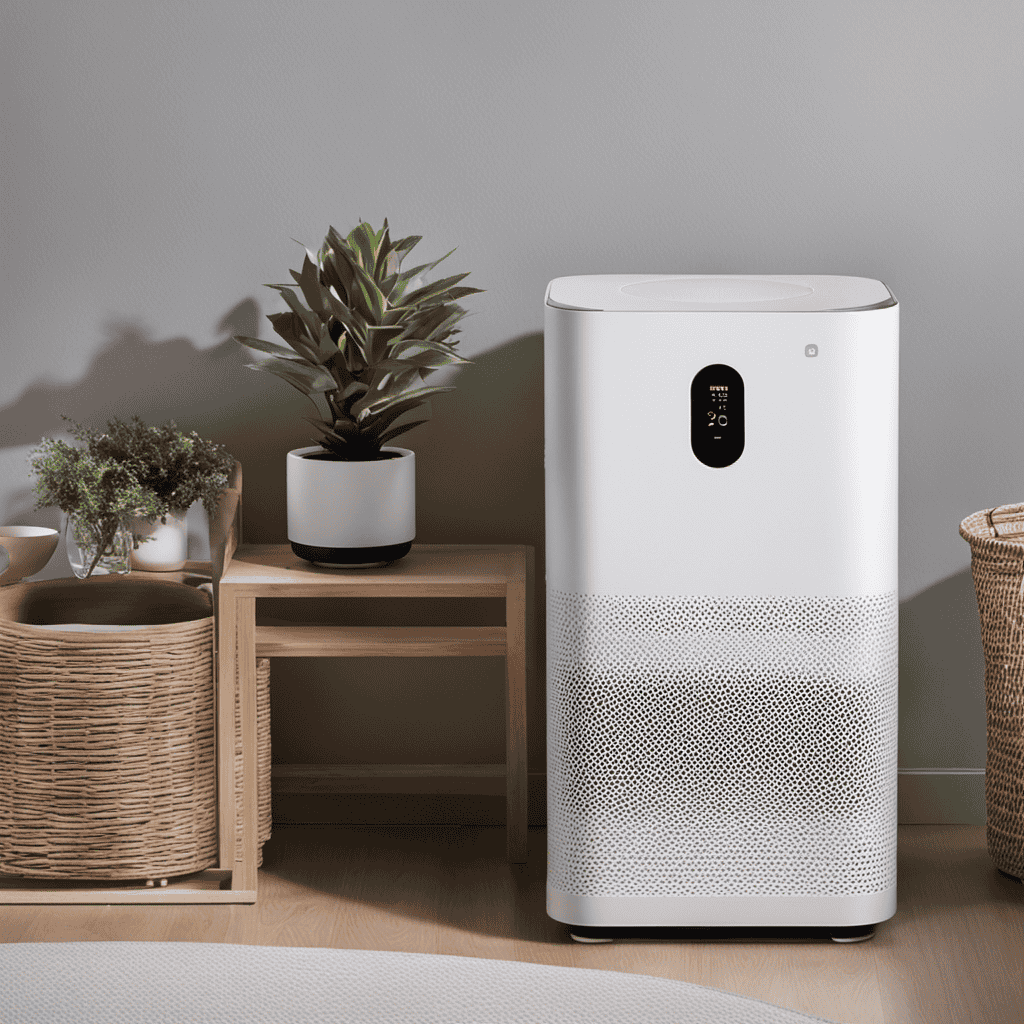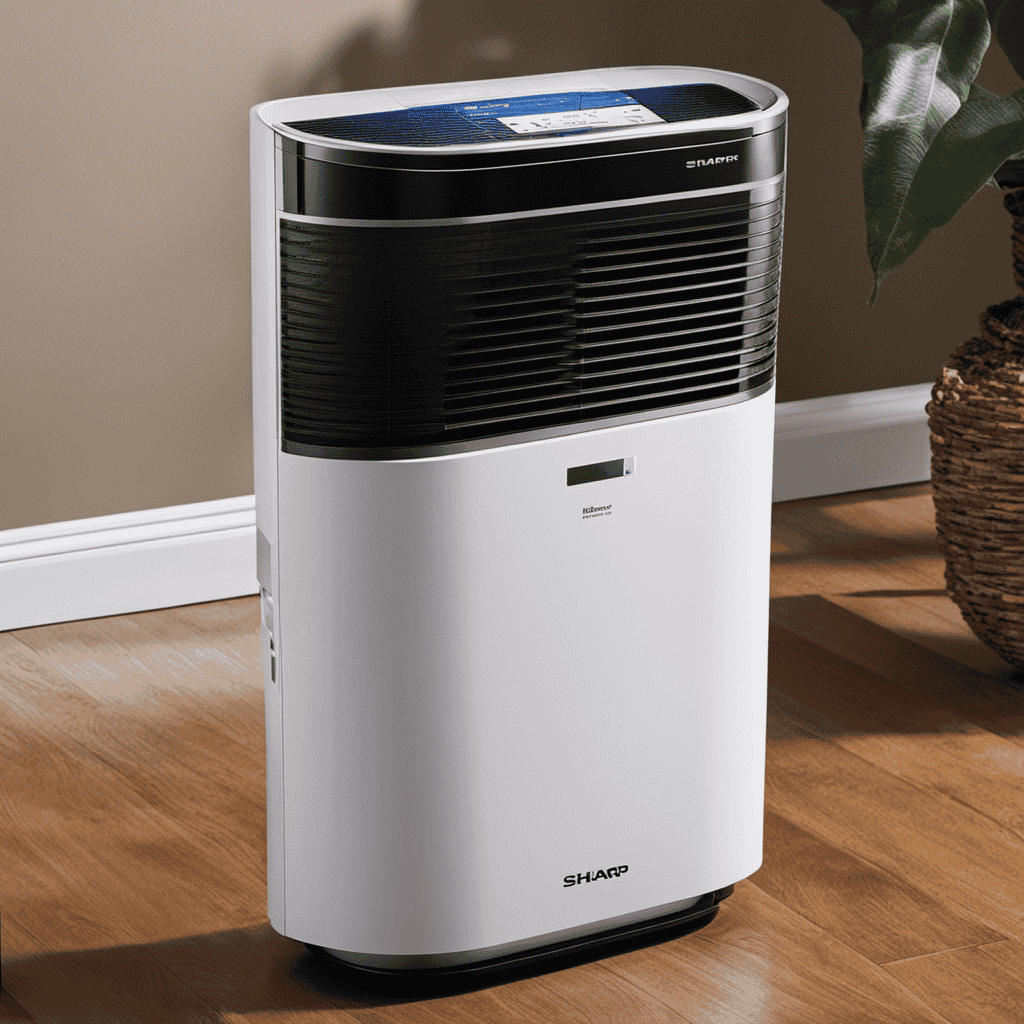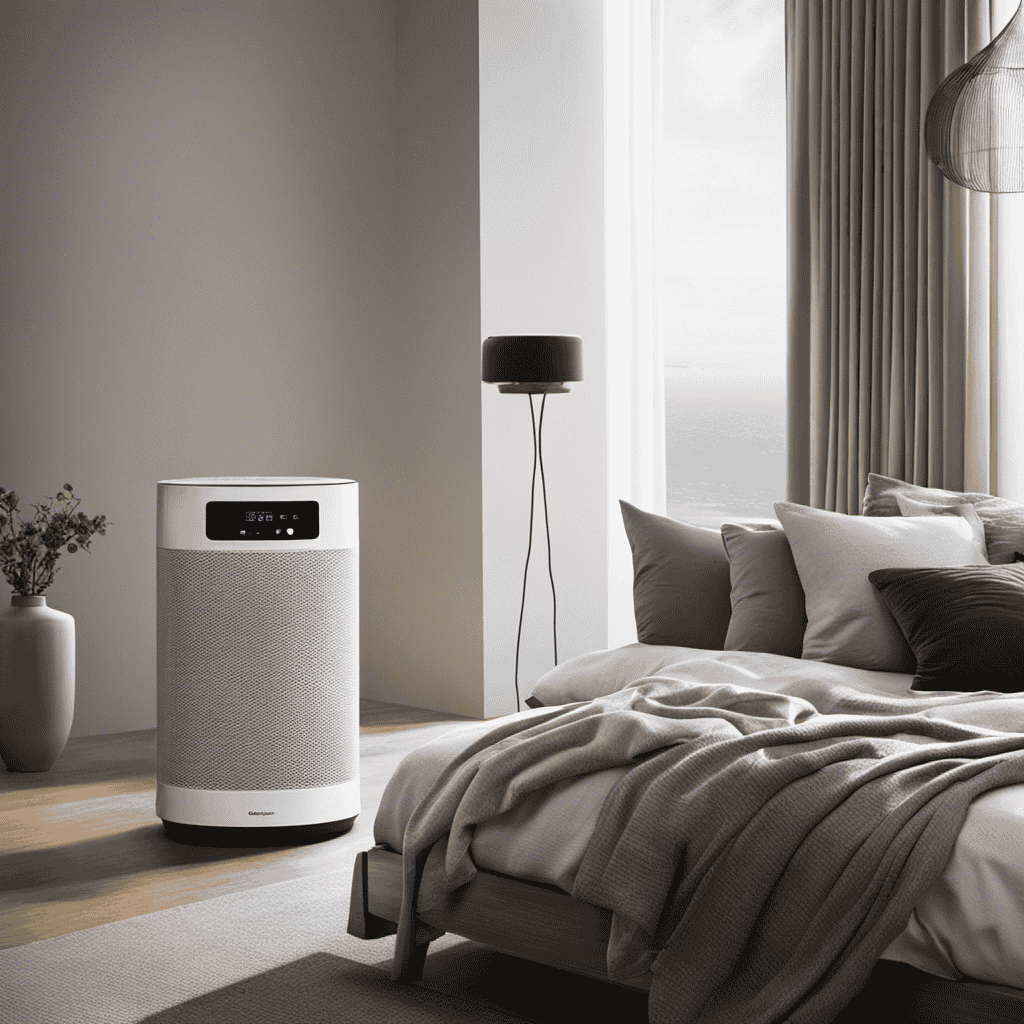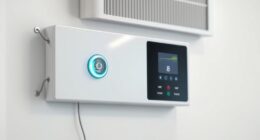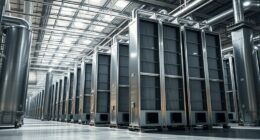In my constant pursuit of better air quality in my home, I often ponder: which is more effective, an air purifier or a humidifier?
Both devices serve distinct purposes and offer unique benefits. In this article, I will delve into the importance of air quality, explain how air purifiers and humidifiers work, and explore the factors to consider when choosing between the two.
By the end, you’ll have a clearer understanding of which option is best suited for your specific needs.
Key Takeaways
- Air purifiers and humidifiers both have their own benefits and advantages, and the choice between the two depends on specific needs and the allergens you are trying to control.
- Air purifiers are effective in removing pollutants and allergens from the air, reducing the risk of respiratory issues and allergies, while humidifiers add moisture to the air, alleviating dryness and improving sleep quality.
- Both air purifiers and humidifiers can help eliminate unpleasant odors and create a fresh and clean environment that enhances relaxation and sleep.
- The different types of air purifiers and humidifiers, such as HEPA filters, activated carbon filters, electrostatic precipitators, and various types of humidifiers, offer different features and advantages in removing pollutants from the air and adding moisture to the environment.
The Importance of Air Quality
If you want to improve the air quality in your home, you should consider using an air purifier or a humidifier.
The importance of air quality cannot be overstated, as it directly impacts our health and well-being.
Poor air quality due to air pollution can have detrimental effects on our respiratory system, leading to an increased risk of respiratory infections, allergies, and asthma.
Research has shown that exposure to pollutants in the air can also have long-term health effects, such as cardiovascular diseases and even lung cancer.
By using an air purifier or a humidifier, you can effectively remove harmful particles and pollutants from the air, creating a cleaner and healthier environment for you and your family.
Understanding Air Purifiers
To understand air purifiers, you should first consider their effectiveness in removing pollutants from the air. They can play a crucial role in improving indoor air quality by capturing and eliminating various contaminants such as dust, pollen, pet dander, and mold spores.
Here are four key aspects to understand about air purifiers:
-
Filtration Technology: Air purifiers use different types of filters, such as HEPA filters, activated carbon filters, or electrostatic precipitators, to trap and remove airborne particles.
-
Coverage Area: The size of the room or area that an air purifier can effectively clean is an important factor to consider when choosing a model.
-
Maintenance: Regular maintenance is necessary to ensure optimal performance. This includes cleaning or replacing filters, and keeping the unit free from dust and debris.
-
Additional Features: Some air purifiers offer additional features like air quality sensors, automatic modes, or smartphone connectivity for enhanced convenience and control.
Understanding these aspects of air purifiers can help you make an informed decision when selecting the right one for your needs.
Keep in mind that regular maintenance, like humidifier maintenance, is necessary to keep your air purifier functioning effectively and prolong its lifespan.
Benefits of Using an Air Purifier
When it comes to improving air quality and finding relief from allergies, using an air purifier can be highly effective.
Research has shown that air purifiers can remove a significant amount of pollutants and allergens from the air, including dust, pet dander, pollen, and mold spores.
This can greatly reduce the risk of respiratory issues and provide much-needed relief for individuals suffering from allergies.
Improved Air Quality
For better air quality, consider using an air purifier or a humidifier in your home. Both of these devices can significantly improve the air you breathe, leading to numerous health benefits.
Here are four ways in which they can enhance your respiratory health and improve sleep quality:
-
Removal of pollutants: Air purifiers effectively filter out allergens, dust, pet dander, and other harmful particles, reducing the risk of respiratory issues and allergies.
-
Humidity regulation: Humidifiers add moisture to the air, which can alleviate dryness in the throat and nasal passages, reducing snoring and improving sleep quality.
-
Reduction of airborne viruses and bacteria: Air purifiers can capture and eliminate airborne germs, reducing the risk of respiratory infections and promoting overall well-being.
-
Odor elimination: Both air purifiers and humidifiers can help eliminate unpleasant odors, creating a fresh and clean environment that enhances relaxation and sleep.
Allergy Relief
If you suffer from allergies, consider investing in an air filtration system or a device that adds moisture to the air in your home.
These two options, air purifiers and humidifiers, can provide relief from allergens and improve indoor air quality.
Air purifiers work by filtering out allergens such as dust, pollen, and pet dander from the air, reducing the presence of these triggers and improving overall air quality.
On the other hand, humidifiers increase the moisture levels in the air, which can help alleviate symptoms associated with dryness, such as dry skin and nasal passages.
Maintaining optimal humidity levels in your home can also prevent the spread of certain allergens, as they thrive in dry environments.
Ultimately, the choice between an air purifier and a humidifier depends on your specific needs and the allergens you are trying to control.
Types of Air Purifiers
When it comes to choosing an air purifier, it’s important to understand the different types of filters available and how they compare in terms of effectiveness against pollutants.
There are several filter types commonly used in air purifiers, such as HEPA, activated carbon, and ionizers. Each filter type has its own strengths and weaknesses when it comes to removing different types of pollutants from the air.
In this discussion, I will compare these filter types and analyze their effectiveness against common pollutants to help you make an informed decision.
Filter Types Comparison
To compare filter types, you should consider the efficiency and maintenance requirements of each option. Here are the advantages and disadvantages of four common filter types:
-
HEPA Filters:
- Advantages: Highly efficient in removing small particles like dust, pollen, and pet dander.
- Disadvantages: Regular replacement is necessary to maintain effectiveness.
-
Activated Carbon Filters:
- Advantages: Excellent at removing odors, chemicals, and volatile organic compounds (VOCs).
- Disadvantages: Less effective in capturing larger particles and may require frequent replacement.
-
Electrostatic Filters:
- Advantages: Can capture both large and small particles without reducing airflow.
- Disadvantages: Regular cleaning is required to prevent dust buildup.
-
UV-C Filters:
- Advantages: Effective in killing bacteria, viruses, and mold spores.
- Disadvantages: Limited to air purification and may not capture larger particles.
Considering these factors will help you choose the filter type that best suits your needs and preferences.
Effectiveness Against Pollutants
The HEPA filter is highly efficient in removing small particles like dust, pollen, and pet dander. Regular replacement is necessary to maintain effectiveness.
However, its effectiveness against viruses is a topic of debate. While HEPA filters can capture some viruses, they may not be able to eliminate all of them. Viruses are much smaller than the particles typically filtered by HEPA filters.
Therefore, additional measures may be required. Using air purifiers with UV-C light or activated carbon filters has been shown to have a greater impact on respiratory health and can help in reducing the spread of viruses.
Now let’s dive into how air purifiers work and explore their different mechanisms.
How Air Purifiers Work
Air purifiers work by filtering out harmful particles in the air, such as dust and pollen. They are designed to improve indoor air quality and have several advantages in terms of air purification and their impact on health. Here are four key points to consider:
-
Removal of Allergens: Air purifiers can effectively remove allergens from the air, providing relief to individuals with allergies or asthma. They capture and trap particles like pet dander, mold spores, and pollen, reducing the risk of allergic reactions.
-
Reduction of Airborne Contaminants: Air purifiers also help remove airborne contaminants such as bacteria, viruses, and smoke particles. This can be particularly beneficial for individuals with respiratory conditions or compromised immune systems.
-
Odor Elimination: Some air purifiers are equipped with activated carbon filters that can help eliminate unpleasant odors from cooking, pets, or chemicals. This can greatly improve the overall indoor air quality and create a more pleasant living environment.
-
Improved Sleep Quality: By removing airborne pollutants and allergens, air purifiers can create a cleaner and healthier sleeping environment. This can lead to better sleep quality, reduced snoring, and improved overall well-being.
Considering these advantages, it’s important to carefully evaluate certain factors when choosing an air purifier.
Factors to Consider When Choosing an Air Purifier
When choosing an air purifier, there are several important factors to consider.
The first is the effectiveness of the filter type. Different air purifiers use different types of filters, such as HEPA filters or activated carbon filters. It is crucial to choose one that can effectively remove the pollutants you are concerned about.
Additionally, you should consider the compatibility of the air purifier with the size of your room. A purifier that is too small for your room may not be able to effectively clean the air. On the other hand, one that is too large may be overkill and unnecessary.
Filter Type Effectiveness
Filter type effectiveness varies between air purifiers and humidifiers. When it comes to air purifiers, there are different types of filters available, each with its own strengths and weaknesses. Here are some key points to consider when it comes to filter effectiveness in air purifiers:
-
HEPA Filters: These are highly effective in removing small particles, such as dust, pollen, and pet dander. They are great for allergy sufferers and those with respiratory issues.
-
Activated Carbon Filters: These are excellent at eliminating odors, chemicals, and volatile organic compounds (VOCs). They are ideal for households with smokers or strong odors.
-
UV-C Filters: These use ultraviolet light to kill bacteria, viruses, and mold spores. They can be beneficial for those concerned about germs and airborne pathogens.
-
Ionizers: These release charged particles into the air, which attach to airborne particles and make them easier to capture by filters. They can enhance the efficiency of other filter types.
When choosing the right filter for your needs, consider the specific pollutants you want to eliminate and the size of your space. Regular filter maintenance, such as cleaning or replacing filters according to manufacturer guidelines, is crucial to ensure optimal performance.
Now, let’s delve into the next aspect: room size compatibility.
Room Size Compatibility
To ensure the air quality in your space is effectively improved, it’s important to consider the compatibility of the purifier or humidifier with the size of your room. Room size limitations play a crucial role in determining the effectiveness of these devices.
When it comes to air purifiers, larger rooms require higher capacity models to effectively clean the air. Smaller purifiers may struggle to cover the entire area, resulting in reduced air quality improvement.
On the other hand, humidifiers are more flexible in terms of room size. While larger rooms may require more powerful humidifiers, smaller ones can still provide adequate moisture.
When considering cost effectiveness in different room sizes, it’s important to balance the initial investment with long-term benefits. Larger rooms may require more expensive devices, but they can provide significant improvements in air quality and comfort.
Noise Level Considerations
When considering which is better between an air purifier and a humidifier, one important factor to consider is the noise level. Noise can be a significant concern, especially if you plan to use the device in your bedroom or any other quiet space.
To help you make an informed decision, here is a noise level comparison between air purifiers and humidifiers:
-
Air Purifiers: Most air purifiers operate at a noise level between 30 to 60 decibels, which is roughly equivalent to a whisper or the sound of a conversation.
-
Humidifiers: On the other hand, humidifiers generally produce a noise level between 20 to 45 decibels, which is similar to the sound of a quiet library or a quiet office.
Ultimately, the choice between an air purifier and a humidifier will depend on your personal preferences. If noise is a concern for you, opting for a humidifier might be the better choice.
Common Air Pollutants and Allergens
You should consider the common air pollutants and allergens when deciding between an air purifier and a humidifier. Airborne contaminants and allergens can have a significant impact on respiratory health. To help you understand the types of pollutants and allergens that can be present in the air, I have created a table below:
| Common Air Pollutants | Common Allergens |
|---|---|
| Dust | Pollen |
| Pet Dander | Mold |
| Smoke | Dust Mites |
| VOCs (Volatile Organic Compounds) | Allergens from pets |
Signs That You Need an Air Purifier
As someone who has experienced allergy symptoms firsthand, I understand the importance of finding ways to alleviate them.
One effective solution that I have come across is the use of air purifiers. These devices are designed to remove indoor pollutants, such as dust, pollen, and pet dander, from the air, which can significantly reduce allergy symptoms.
Allergy Symptoms and Air Purifiers
Don’t forget that air purifiers can help alleviate allergy symptoms. As someone who has struggled with allergies for years, I can attest to the effectiveness of air purifiers in reducing the frequency and severity of my symptoms.
Here are four reasons why air purifiers are a great investment for allergy sufferers:
-
Removes allergens: Air purifiers can effectively filter out common allergens such as pollen, dust mites, pet dander, and mold spores. This helps to create a cleaner and healthier indoor environment.
-
Improves air quality: By removing pollutants and irritants from the air, air purifiers can greatly improve the overall air quality in your home. This can help reduce allergy symptoms and improve respiratory health.
-
Reduces exposure to triggers: Air purifiers can help to minimize your exposure to allergens, especially during peak allergy seasons. This can provide relief and prevent allergy flare-ups.
-
Provides continuous relief: Unlike medications that provide temporary relief, air purifiers work continuously to remove allergens from the air. This means that you can experience long-term relief from allergy symptoms.
While humidifiers have their own benefits, such as adding moisture to the air, air purifiers are specifically designed to target and remove allergens. So, if you’re looking to alleviate allergy symptoms, investing in an air purifier is a wise choice.
Indoor Pollutant Sources
Indoor pollutant sources can contribute to poor air quality in your home, affecting your respiratory health. The health effects of indoor pollutants are well-documented and can range from mild irritation to serious respiratory conditions.
Common indoor pollutants include volatile organic compounds (VOCs) from cleaning products and furniture, tobacco smoke, mold spores, and pet dander. These pollutants can exacerbate allergies, trigger asthma attacks, and even lead to long-term respiratory problems.
Fortunately, there are strategies for reducing indoor air pollution and improving the quality of the air you breathe. One effective approach is to ensure proper ventilation by opening windows regularly or using exhaust fans in areas prone to moisture and pollutants.
Regular cleaning and dusting can help remove allergens and particles from surfaces. Additionally, using air purifiers with HEPA filters can help capture and remove harmful pollutants from the air.
Understanding Humidifiers
Humidifiers can help add moisture to dry indoor air, making it more comfortable to breathe. As someone who suffers from respiratory issues, I understand the importance of maintaining the right humidity levels in my home. Here are four key points to understand about the role of humidity in respiratory health and the ideal humidity levels:
-
Optimal Humidity Levels: The ideal indoor humidity level for respiratory health is between 30% to 50%. This range helps to keep respiratory passages moist, reducing the risk of irritation and discomfort.
-
Sinus Relief: Adequate humidity can alleviate sinus congestion and dryness, making it easier to breathe and reducing the likelihood of sinus infections.
-
Asthma Management: Proper humidity levels can help manage asthma symptoms by preventing airway irritation and reducing the frequency of asthma attacks.
-
Respiratory Infections: Maintaining optimal humidity can also decrease the likelihood of respiratory infections, as viruses and bacteria thrive in dry environments.
Understanding the importance of humidity in respiratory health and maintaining the ideal levels is crucial for creating a comfortable and healthy indoor environment.
Benefits of Using a Humidifier
You’ll be pleased to know that using a humidifier can provide numerous benefits for your respiratory health.
Research has shown that maintaining an optimal level of humidity in your home can help alleviate symptoms of respiratory conditions such as asthma, allergies, and dry cough. By adding moisture to the air, a humidifier can help soothe irritated nasal passages, reduce congestion, and prevent dryness in the throat and airways.
Additionally, proper humidity levels can improve sleep quality by reducing snoring and promoting better breathing during sleep. These benefits are particularly important during the dry winter months or in environments with low humidity.
Now, let’s explore the different types of humidifiers and their specific features.
Types of Humidifiers
Now, let’s take a look at the different types of humidifiers available on the market. Here are four common types:
-
Ultrasonic Humidifiers: These use ultrasonic vibrations to break water into a fine mist, making them quiet and energy-efficient.
-
Evaporative Humidifiers: These work by blowing air over a wet wick or filter, causing water to evaporate and increase humidity levels.
-
Steam Humidifiers: These units heat water to produce steam, which is then released into the air. They are effective at eliminating bacteria and allergens.
-
Impeller Humidifiers: These humidifiers use rotating discs to generate a cool mist. They are often used in children’s rooms due to their safe and quiet operation.
Humidifiers offer numerous benefits, including alleviating dry skin, reducing respiratory issues, and preventing the spread of viruses. Depending on your needs and preferences, you can choose the most suitable type of humidifier to improve the air quality in your home.
How Humidifiers Work
To understand how humidifiers work, it’s important to know that they increase the moisture in the air, making it more comfortable to breathe.
Humidifiers have both pros and cons. One of the main advantages is that they can alleviate dry skin and respiratory symptoms caused by dry air. They can also help with sinus congestion and allergies. However, if not properly maintained, humidifiers can become a breeding ground for bacteria and mold, leading to potential health risks.
When it comes to choosing between cool mist and warm mist humidifiers, there are a few key differences. Cool mist humidifiers are generally safer to use around children and pets because they don’t produce hot steam. On the other hand, warm mist humidifiers can provide soothing relief for nasal congestion.
It’s important to consider your specific needs and preferences when deciding which type of humidifier to use.
Factors to Consider When Choosing a Humidifier
Now that we understand how humidifiers work, let’s explore some important factors to consider when choosing a humidifier.
Proper maintenance and control of humidity levels are key to ensuring the effectiveness and longevity of your humidifier.
Here are four factors to keep in mind:
-
Maintenance Requirements: Consider the ease of cleaning and refilling the humidifier. Look for models with removable parts and dishwasher-safe components for hassle-free maintenance.
-
Type of Humidifier: There are different types of humidifiers available, such as ultrasonic, evaporative, and steam humidifiers. Each type has its own advantages and maintenance needs, so choose one that suits your preferences.
-
Coverage Area: Determine the size of the area you want to humidify. Make sure the humidifier you choose is capable of covering that space effectively.
-
Humidity Control: Look for humidifiers with adjustable settings that allow you to control the humidity level in your home. This feature ensures optimal comfort and prevents excessive moisture or dryness.
By considering these factors, you can select a humidifier that meets your needs and is easy to maintain.
Now, let’s move on to discussing common issues with indoor air quality.
Common Issues With Indoor Air Quality
One common issue with indoor air quality is the presence of allergens that can trigger respiratory symptoms. Indoor air pollution prevention is crucial to reduce the health effects of poor indoor air quality.
Studies have shown that exposure to pollutants indoors can lead to various respiratory conditions such as asthma, allergies, and even lung cancer. These pollutants can come from various sources including dust, pet dander, mold spores, and volatile organic compounds (VOCs) emitted by household products.
To maintain a healthy indoor environment, it is important to address these common issues by implementing effective strategies such as proper ventilation, regular cleaning, and minimizing the use of chemical-based products.
Which Is Better: Air Purifier or Humidifier?
Considering your specific needs and preferences, it’s important to determine whether an air purifier or a humidifier would be more beneficial for improving your indoor air quality. To help you make an informed decision, here is a comparison between the two:
-
Air Purifier:
- Removes harmful particles like dust, pollen, and pet dander from the air.
- Filters out allergens, improving respiratory health and reducing allergy symptoms.
- Eliminates odors and traps smoke, creating a fresher and cleaner environment.
- Reduces the risk of respiratory infections by eliminating airborne bacteria and viruses.
-
Humidifier:
- Adds moisture to the air, preventing dryness and improving respiratory and skin health.
- Relieves symptoms of dry throat, dry skin, and chapped lips.
- Reduces the risk of respiratory infections by keeping the respiratory tract moist.
- Helps alleviate congestion and coughing caused by dry air.
Ultimately, the choice between an air purifier and a humidifier depends on your specific needs and the air quality issues you are facing.
Frequently Asked Questions
Can an Air Purifier Also Function as a Humidifier?
An air purifier and a humidifier serve different purposes. While an air purifier helps to remove pollutants from the air, a humidifier adds moisture to the air. They each have their own benefits and cannot function interchangeably.
What Are the Potential Health Risks Associated With Using an Air Purifier or Humidifier?
Using an air purifier or humidifier may have potential health risks. It is important to consider factors such as allergies, respiratory conditions, and maintenance requirements before deciding which appliance is better suited for your specific needs.
Are There Any Specific Brands or Models of Air Purifiers or Humidifiers That Are Recommended?
I recommend researching specific brands and models of air purifiers and humidifiers to find the best fit for your needs. Consider the pros and cons of each, such as air purification capabilities and humidity control.
Is It Necessary to Use Both an Air Purifier and a Humidifier in the Same Room?
Using an air purifier and humidifier together can provide multiple benefits, such as improving air quality and maintaining optimal humidity levels. However, using only one has its pros and cons, depending on the specific needs of the room.
Are There Any Maintenance or Cleaning Requirements for Air Purifiers or Humidifiers?
To properly maintain and clean air purifiers and humidifiers, regular maintenance is required. Air purifiers often need filter replacement, while humidifiers require regular cleaning to prevent the growth of mold and bacteria.
Conclusion
After conducting extensive research and analysis, it’s clear that there is no definitive answer to the question of whether an air purifier or a humidifier is better.
Both devices have their own unique benefits and serve different purposes in improving indoor air quality.
It ultimately depends on the specific needs and preferences of the individual. Therefore, it’s recommended to assess the indoor environment and consider factors such as allergies, respiratory conditions, and humidity levels before making a decision.
The key is to find a balance that promotes a healthy and comfortable living space.
